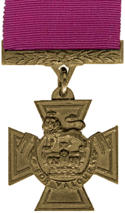James Bulmer Johnson
James Bulmer Johnson VC | |
|---|---|
 | |
| Born | 31 December 1889 Widdrington, Northumberland |
| Died | 23 March 1943 (aged 53)) Plymouth, Devon |
| Buried | |
| Allegiance | |
| Service | |
| Rank | Second Lieutenant |
| Unit | The Northumberland Fusiliers |
| Battles / wars | First World War Anglo-Irish War |
| Awards | Victoria Cross |
| Other work | Police officer |
James Bulmer Johnson VC (31 December 1889 – 23 March 1943) was an English recipient of the Victoria Cross, the highest and most prestigious award for gallantry in the face of the enemy that can be awarded to British and Commonwealth forces.
He was a Second Lieutenant in the 2nd Battalion, The Northumberland Fusiliers, British Army, attached to 36th Battalion during the First World War and 28 years old when on 14 October 1918 south west of Wez Macquart, France, he performed the act for which he was awarded the VC.
During operations by strong patrols, Second Lieutenant Johnson repelled frequent counter-attacks and for six hours, under heavy fire, he held back the enemy. When at length he was ordered to retire he was the last to leave the advanced position carrying a wounded man. Three times subsequently this officer returned and brought in badly wounded men under intense enemy machine-gun fire.[1]
After World War I, Johnson served in the Auxiliary Division of the Royal Irish Constabulary.[2]
He died in Plymouth, Devon, in 1943 aged fifty-three, and was cremated at Efford Crematorium, Plymouth.
The medal
His Victoria Cross is displayed at the Fusiliers Museum of Northumberland, Alnwick, Northumberland.
References
- ^ "No. 31082". The London Gazette (Supplement). 26 December 1918. p. 15118.
- ^ A D Harvey, "Who Were the Auxiliaries?" Historical Journal 35, no. 3 (1992): 665-69.
- Monuments to Courage (David Harvey, 1999)
- The Register of the Victoria Cross (This England, 1997)
- VCs of the First World War - The Final Days 1918 (Gerald Gliddon, 2000)
External links
- Location of grave and VC medal (Devonshire)
- James Bulmer Johnson at Find a Grave
